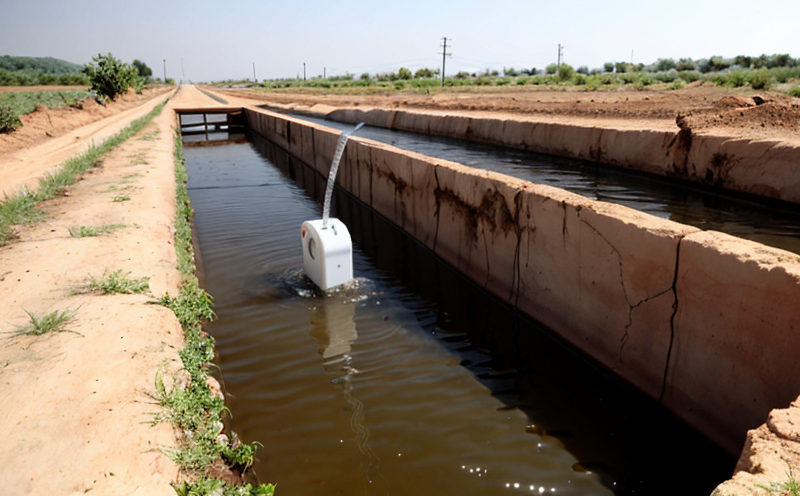ASTM D511 Calcium and Magnesium in Water Testing
The ASTM D511 standard practice is a fundamental tool in the analysis of calcium and magnesium content in water samples. This method provides detailed guidelines for the determination of these essential minerals, which play critical roles in various industrial processes and environmental assessments within mining operations.
Calcium and magnesium are central to many chemical reactions that occur naturally in groundwater systems, making their accurate measurement crucial for understanding the quality and potential impacts on mining operations. These elements influence water hardness, solubility of minerals, and the efficiency of certain treatment processes. In the context of mining, accurate quantification ensures compliance with regulatory standards and supports informed decision-making.
The ASTM D511 method employs a combination of gravimetric analysis and titrimetry to measure calcium and magnesium in water samples. This approach leverages precise chemical reactions and standard procedures to achieve reliable results. The process involves the precipitation of calcium and magnesium ions using ammonium oxalate, followed by filtration, drying, and weighing of the precipitate formed.
Accurate measurement is paramount for mining operations that rely on water quality data to optimize processes like flotation, sedimentation, and chemical treatment. By adhering strictly to ASTM D511, laboratories can ensure consistent and reproducible results across different samples and locations, thereby enhancing operational efficiency and environmental stewardship.
The importance of this test cannot be overstated in the mining sector. Understanding water hardness is essential for predicting potential scaling issues within machinery and pipelines, optimizing reagent consumption during treatment processes, and ensuring compliance with local and international regulations regarding water quality discharge standards.
Given its critical role in maintaining operational efficiency and environmental compliance, ASTM D511 calcium and magnesium testing is a cornerstone of effective mining management. By leveraging this standard, mining companies can gain invaluable insights into the composition of their water resources, enabling them to make informed decisions that enhance both productivity and sustainability.
Quality and Reliability Assurance
The ASTM D511 method is renowned for its robustness and reliability in measuring calcium and magnesium content. This standard ensures consistent, accurate results by providing clear guidelines on sample preparation, reagent use, and analytical techniques. The method's precision is further enhanced through the implementation of quality control measures such as regular calibration checks and the use of certified reference materials.
By adhering to ASTM D511, laboratories can maintain high standards of accuracy and reliability in their water testing processes. This commitment to quality not only ensures compliance with regulatory requirements but also enhances the confidence of stakeholders in the integrity of the test results. The method's widespread acceptance within the mining industry underscores its role as a trusted benchmark for calcium and magnesium analysis.
The ASTM D511 protocol is designed to minimize variability in the testing process, ensuring that results are repeatable and comparable across different laboratories. This consistency is particularly important in the context of large-scale mining operations where water quality can vary significantly between sites. By adopting this standard, organizations can establish a uniform approach to water testing, facilitating better communication and collaboration among stakeholders.
Furthermore, ASTM D511 promotes transparency and accountability by providing detailed documentation of all steps involved in the testing process. This level of detail ensures that any discrepancies or anomalies can be traced back to specific procedures, thereby fostering trust and confidence in the test results. The standard's emphasis on quality control also extends to personnel training, ensuring that operators are well-versed in the latest techniques and best practices.
The reliability of ASTM D511 lies not only in its technical specifications but also in its ability to deliver consistent results across diverse sample types and environmental conditions. This versatility makes it an indispensable tool for mining operations that require precise water quality data, whether for internal processes or external reporting purposes.
Competitive Advantage and Market Impact
- Compliance with stringent regulatory requirements: By adhering to ASTM D511, mining companies ensure that they meet all relevant standards for water quality discharge. This compliance not only reduces the risk of legal penalties but also enhances a company's reputation as an environmentally responsible entity.
- Improved operational efficiency: Accurate calcium and magnesium testing allows mines to optimize their treatment processes, reducing waste and increasing overall productivity. This leads to cost savings and improved resource management.
- Informed decision-making: Reliable data on water quality enables mining organizations to make informed decisions regarding process improvements and environmental initiatives. Such insights can lead to significant long-term benefits, including reduced environmental impact and enhanced sustainability practices.
Use Cases and Application Examples
In the context of mining, ASTM D511 calcium and magnesium testing serves multiple critical functions. For instance, in flotation processes, accurate measurement of these minerals is essential for optimizing reagent usage, which directly impacts operational costs. By precisely quantifying calcium and magnesium, mines can ensure that flotation frothers are used efficiently, leading to higher recovery rates and reduced waste.
Water hardness testing also plays a vital role in sedimentation processes, where understanding the mineral content helps in designing more effective settling tanks. This ensures that valuable resources such as iron or copper are not lost due to inefficient separation techniques. Moreover, accurate calcium and magnesium analysis is crucial for monitoring the effectiveness of water treatment systems, ensuring that they meet both internal quality standards and external regulatory requirements.
In environmental impact assessments, ASTM D511 provides critical data on the mineral content of discharge waters. This information helps mining companies assess their potential environmental footprint and implement mitigation strategies to minimize harm to local ecosystems. By adhering to this standard, mines can demonstrate their commitment to sustainable practices and gain a competitive edge in an increasingly environmentally conscious market.
Furthermore, ASTM D511 calcium and magnesium testing supports research and development efforts aimed at improving water treatment technologies. By providing reliable data on mineral content, this method enables engineers to innovate more efficient and effective solutions for mining operations. This continuous improvement cycle ensures that the industry remains at the forefront of technological advancements.





